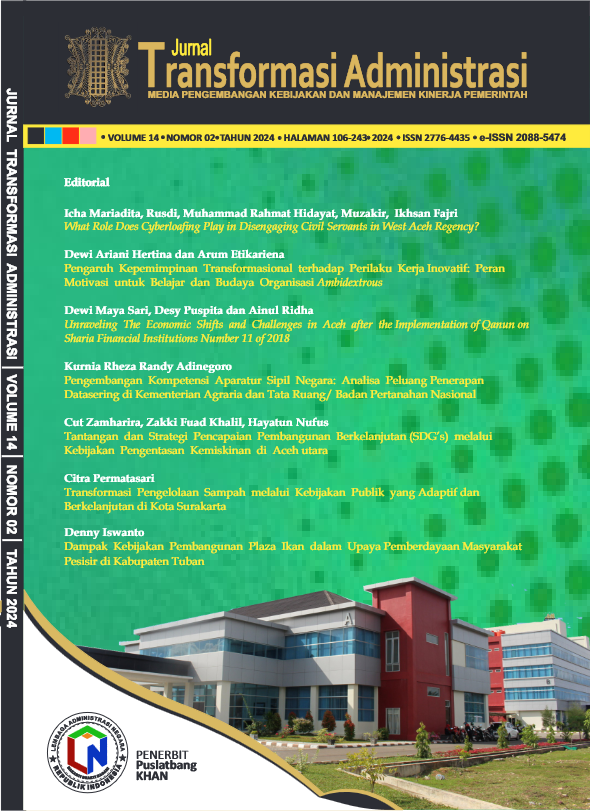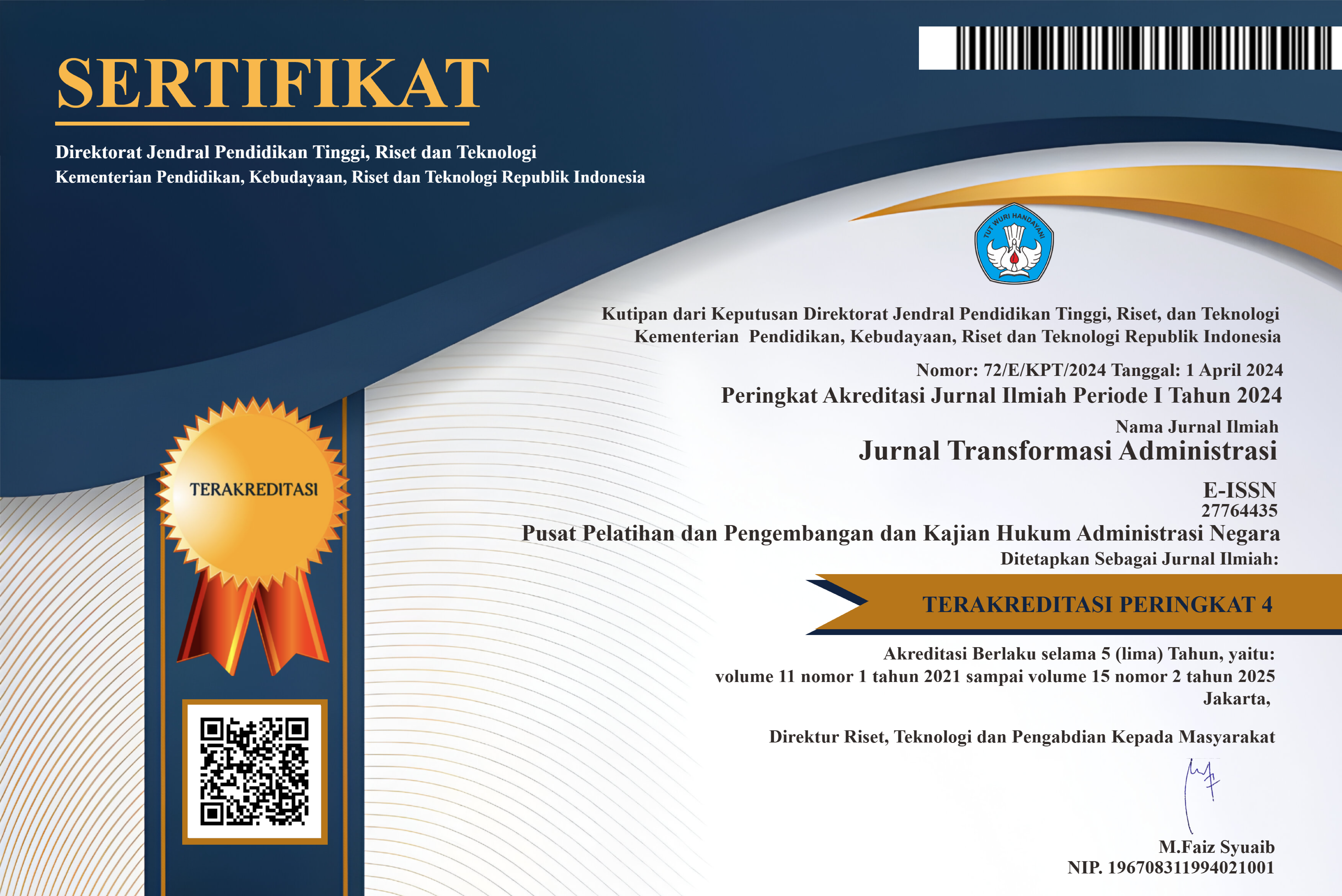WHAT ROLE DOES CYBERLOAFING PLAY IN DISENGAGING CIVIL SERVANTS IN WEST ACEH REGENCY?
Keywords:
Employee Disengagement, Cyberloafing, Job PerformanceAbstract
This study investigates the interrelationships among various latent variables and their observed indicators using a structural equation model (SEM). The findings reveal that sharing, shopping, and real-time updating activities positively impact job-related outcomes, suggesting that moderate engagement in these activities can mitigate employee disengagement. Conversely, accessing online content shows a slight negative influence on job performance, highlighting the potential detriments of cyberloafing. The study also underscores the significant positive impact of organizational support and supervisory evaluations on job performance. Integrating theories of cyberloafing and employee disengagement, the results suggest that fostering a supportive work environment and allowing for healthy, non-work-related activities can enhance job satisfaction and reduce counterproductive behaviors. The implications of these findings are critical for designing interventions and policies that promote positive engagement and minimize the risks associated with cyberloafing, ultimately enhancing overall employee performance and satisfaction.
References
A., S. T., & Pattar, M. (2018). Pattern of internet addiction among urban and rural school students, Mangaluru, India: a comparative cross-sectional study. International Journal of Contemporary Pediatrics, 5(5), 1750. https://doi.org/10.18203/2349-3291.ijcp20183005
Abubakar, A. M., Namin, B. H., Harazneh, I., Arasli, H., & Tunç, T. (2017). Does gender moderates the relationship between favoritism/nepotism, supervisor incivility, cynicism and workplace withdrawal: A neural network and SEM approach. Tourism Management Perspectives, 23, 129–139. https://doi.org/10.1016/j.tmp.2017.06.001
Aktas, H., Ayhan, B., & Altunbas, H. (2013). Internet and the youth: Internet addiction among university students in Kyrgyzstan. 11th International Symposium: Communication in the Millennium, May 2013, 244–250. https://www.academia.edu/4450393
Aybas, M., & Gungor, A. Y. (2020). Does Cyberloafing reduce academic performance? A comparative study between Turkey and Poland. Revista Argentina De Clinica Psicologica, XXIX(5), 1060–1072. https://doi.org/10.24205/03276716.2020.1101
Bakker, A. B., & Demerouti, E. (2007). The Job Demands-Resources model: State of the art. Journal of Managerial Psychology, 22(3), 309–328. https://doi.org/10.1108/02683940710733115
Bedarkar, M., & Pandita, D. (2014). A Study on the Drivers of Employee Engagement Impacting Employee Performance. Procedia - Social and Behavioral Sciences, 133, 106–115. https://doi.org/10.1016/j.sbspro.2014.04.174
Benbya, H., Nan, N., Tanriverdi, H., & Yoo, Y. (2020). Complexity and information systems research in the emerging digital world. MIS Quarterly: Management Information Systems, 44(1), 1–17. https://doi.org/10.25300/MISQ/2020/13304
Brouer, R. L., Harris, K. J., & Kacmar, K. M. (2010). The moderating effects of political skill on the perceived politics–outcome relationships. Journal of Organizational Behavior, 32(1), 869–885. https://doi.org/10.1002/job
Byun, G., Lee, S., Karau, S. J., & Dai, Y. (2020). Sustaining collaborative effort in work teams: Exchange ideology and employee social loafing. Sustainability (Switzerland), 12(15), 1–14. https://doi.org/10.3390/SU12156241
Caplan, S. E. (2002). Problematic Internet use and psychosocial well-being: Development of a theory-based cognitive-behavioral measurement instrument. Computers in Human Behavior, 18(5), 553–575. https://doi.org/10.1016/S0747-5632(02)00004-3
Dessler, G. (2018). I am sharing “Gary Dessler - Human resource management-Pearson (2020)” with you. In Human resource management / Gary Dessler, Florida International University.
Dhawan, V., Kang, T. K., & Sharma, S. (2020). Pattern of internet addiction among rural and urban adolescents. Indian Journal of Health and Well-Being, 11(10–12), 508–514.
Elciyar, K., & Simsek, A. (2021). An investigation of cyberloafing in a large-scale technology organization from the perspective of the theory of interpersonal behavior. Online Journal of Communication and Media Technologies, 11(2), 1–15. https://doi.org/10.30935/ojcmt/10823
Gottman, J. M., Coan, J., Carrere, S., Swanson, C., Gottman, J. M., Coan, J., Carrere, S., & Swanson, C. (1998). Predicting Marital Happiness and Stability from Newlywed Interactions Published by : National Council on Family Relations Predicting Marital Happiness and Stability from Newlywed Interactions. Journal of Marriage and Family, 60(1), 5–22. https://doi.org/10.1002/job
Harkins, S. G., Latané, B., & Williams, K. (1980). Social loafing: Allocating effort or taking it easy? Journal of Experimental Social Psychology, 16(5), 457–465. https://doi.org/10.1016/0022-1031(80)90051-7
Isaksson, A. J., Harjunkoski, I., & Sand, G. (2018). The impact of digitalization on the future of control and operations. Computers and Chemical Engineering, 114, 122–129. https://doi.org/10.1016/j.compchemeng.2017.10.037
Jia, H., Jia, R., & Karau, S. (2013). Cyberloafing and personality: The impact of the Big Five traits and workplace situational factors. Journal of Leadership and Organizational Studies, 20(3), 358–365. https://doi.org/10.1177/1548051813488208
Kaptangil, K., Asan, K., & Kinay, A. G. (2021). The effect of the cyberloafing behaviors of tourism business employees on business motivations and organizational identification. Tourism and Management Studies, 17(1), 31–43. https://doi.org/10.18089/TMS.2021.170103
Koay, K. Y., Soh, P. C. H., & Chew, K. W. (2017). Do employees’ private demands lead to cyberloafing? The mediating role of job stress. Management Research Review, 40(9), 1025–1038. https://doi.org/10.1108/MRR-11-2016-0252
Lim, V. K. G. (2002). The IT way of loafing on the job. Journal of Organizational Behavior, 23(5), 675–694. https://www.jstor.org/stable/4093671
Lim, V. K. G., & Chen, D. J. Q. (2012). Cyberloafing at the workplace: Gain or drain on work? Behaviour and Information Technology, 31(4), 343–353. https://doi.org/10.1080/01449290903353054
Lim, V. K. G., & Teo, T. S. H. (2005). Prevalence, perceived seriousness, justification and regulation of cyberloafing in Singapore: An exploratory study. Information and Management, 42(8), 1081–1093. https://doi.org/10.1016/j.im.2004.12.002
Lyons, R., Lynn, T., & Mac an Bhaird, C. (2017). Social loafing in student entrepreneurship teams. The Emergence of Entrepreneurial Behaviour: Intention, Education and Orientation, August, 140–164. https://doi.org/10.4337/9781786434432.00013
Menguc, B., Auh, S., Fisher, M., & Haddad, A. (2013). To be engaged or not to be engaged: The antecedents and consequences of service employee engagement. Journal of Business Research, 66(11), 2163–2170. https://doi.org/10.1016/j.jbusres.2012.01.007
Metin-Orta, I., & Demirtepe-Saygılı, D. (2021). Cyberloafing behaviors among university students: Their relationships with positive and negative affect. Current Psychology, 0123456789. https://doi.org/10.1007/s12144-021-02374-3
Meydan, C. H. (2014). Social Loafing and Impression Management in an Organizational Context. International Review of Management and Marketing, July.
Mirza, & Santoso, H. (2019). INTERNET DAN PERILAKU CYBERLOAFING PADA KARYAWAN. Psikoislamedia Jurnal Psikologi, 4(1), 26–35.
Munene, A.G., & Nyaribo, Y. M. (2013). Effect of social media pertication in the workplace on employee productivity. International Journal of Advances in Management and Economics, 141–150.
Newman, B. M., & Newman, P. R. (2020). Self-regulation theories. In Theories of Adolescent Development. https://doi.org/10.1016/b978-0-12-815450-2.00008-5
Oktanofa, A. K., Arliawan, F. A., & Gustomo, A. (2022). Measuring and Improving Employee Engagement (A Study in PT. Svara Inovasi Indonesia). IPTEK Journal of Proceedings Series, 0(1), 425. https://doi.org/10.12962/j23546026.y2020i1.11945
Ozler, N. D. E., & Polat, G. (2012). Cyberloafing Phenomenon in Organizations: Determinants and Impacts. International Journal of EBusiness and EGovernment Studies, 4(2), 1–15.
Prasad, S., Gupta, I. C., & Totala, N. K. (2017). Social media usage, electronic word of mouth and purchase-decision involvement. In Asia-Pacific Journal of Business Administration (Vol. 9, Issue 2). https://doi.org/10.1108/APJBA-06-2016-0063
Rasool, S. F., Wang, M., Zhang, Y., & Samma, M. (2020). Sustainable work performance: the roles of workplace violence and occupational stress. International Journal of Environmental Research and Public Health, 17(3), 1–12. https://doi.org/10.3390/ijerph17030912
Ren, Y., Yang, J., & Liu, L. (2017). Social anxiety and internet addiction among rural left-behind children: The mediating effect of loneliness. Iranian Journal of Public Health, 46(12), 1659–1668.
Saidin, S. S., Iskandar, Y. H. P., & Dahlan, N. (2017). The impact of cyberloafing towards Malaysia employees’ productivity: A conceptual framework. Proceedings - 2017 International Conference on Electrical Engineering and Informatics: Advancing Knowledge, Research, and Technology for Humanity, ICELTICs 2017, 2018-January (ICELTICs), 216–220. https://doi.org/10.1109/ICELTICS.2017.8253278
Saikia, A. M., Das, J., Barman, P., & Bharali, M. D. (2019). Internet Addiction and its Relationships with Depression, Anxiety, and Stress in Urban Adolescents of Kamrup District, Assam. Journal of Family and Community Medicine, 26(2), 108–112. https://doi.org/10.4103/jfcm.JFCM_93_18
Schippers, M. C. (2014). Social loafing tendencies and team performance: The compensating effect of agreeableness and conscientiousness. Academy of Management Learning and Education, 13(1), 62–81. https://doi.org/10.5465/amle.2012.0191
Siew, S. C., Gan, P. L., & Ramayah, T. (2017). A review of the theories in cyberloafing studies. Advanced Science Letters, 23(9), 9174–9176. https://doi.org/10.1166/asl.2017.10049
Soh, P. C.-H., Koay, K.-Y., & Chew, K.-W. (2017). Conceptual view of Cyberloafing and Non-Work Domain. SHS Web of Conferences, 33, 00029. https://doi.org/10.1051/shsconf/20173300029
Syed, S. (2020). The Impact of Cyberloafing on Employees’ Job Performance: A Review of Literature. Journal of Advances in Management Sciences & Information Systems, 6(June), 16–28. https://doi.org/10.6000/2371-1647.2020.06.02
Syed, S., Singh, H., Thangaraju, S. K., Bakri, N. E., Hwa, K. Y., & Kusalavan, P. (2020). The Impact of Cyberloafing on Employees’ Job Performance: A Review of Literature. Journal of Advances in Management Sciences & Information Systems, 6(November), 16–28. https://doi.org/10.6000/2371-1647.2020.06.02
Tandon, A., Dhir, A., Almugren, I., AlNemer, G. N., & Mäntymäki, M. (2021). Fear of missing out (FoMO) among social media users: a systematic literature review, synthesis and framework for future research. Internet Research, 31(3), 782–821. https://doi.org/10.1108/INTR-11-2019-0455
Van Doorn, O. N. (2011). Cyberloafing : A multi-dimensional construct placed in a theoretical framework. In Master of Science in Innovation Management (Issue August).
Wagner, D. T., Barnes, C. M., Lim, V. K. G., & Ferris, D. L. (2012). Lost sleep and cyberloafing: Evidence from the laboratory and a daylight saving time quasi-experiment. Journal of Applied Psychology, 97(5), 1068–1076. https://doi.org/10.1037/a0027557
Yeik, K. K., Soh, P. C. H., Wai, C. K., Chin, P., Soh, H., & Chew, K. (2013). A Proposed Conceptual Model of Internet Use, Addiction and Job Productivity in Malaysia. 11th Asian Academy of Management International Conference, February 2017, 825–835.
Yuniawan, A., Filatrovi, E. W., & Arraniri, I. (2021). Generation Z and organizational citizenship behavior of sharia banking. Jurnal Siasat Bisnis, 25(2), 131–141. https://doi.org/10.20885/jsb.vol25.iss2.art4
Yuningsih, Y. (2021). Implementasi e-Learning di Masa Pandemi Covid-19 : Studi Kasus pada Pelatihan Dasar Calon Pegawai Negeri Sipil di Puslatbang PKASN LAN e-Learning Implementation in Covid-19 Pandemic Era : Case Study on Basic Training of Prospective Civil Servants in Pusla. Jurnal Wacana Kinerja, 24.
Downloads
Published
How to Cite
Issue
Section
License
Copyright (c) 2025 Jurnal Transformasi Administrasi

This work is licensed under a Creative Commons Attribution 4.0 International License.















